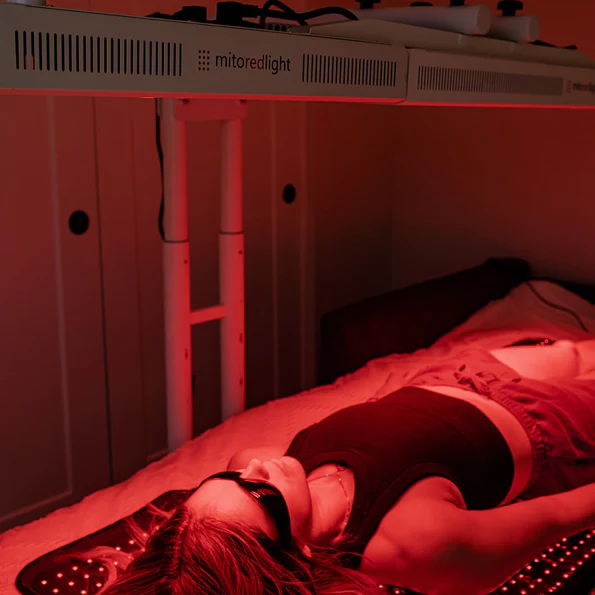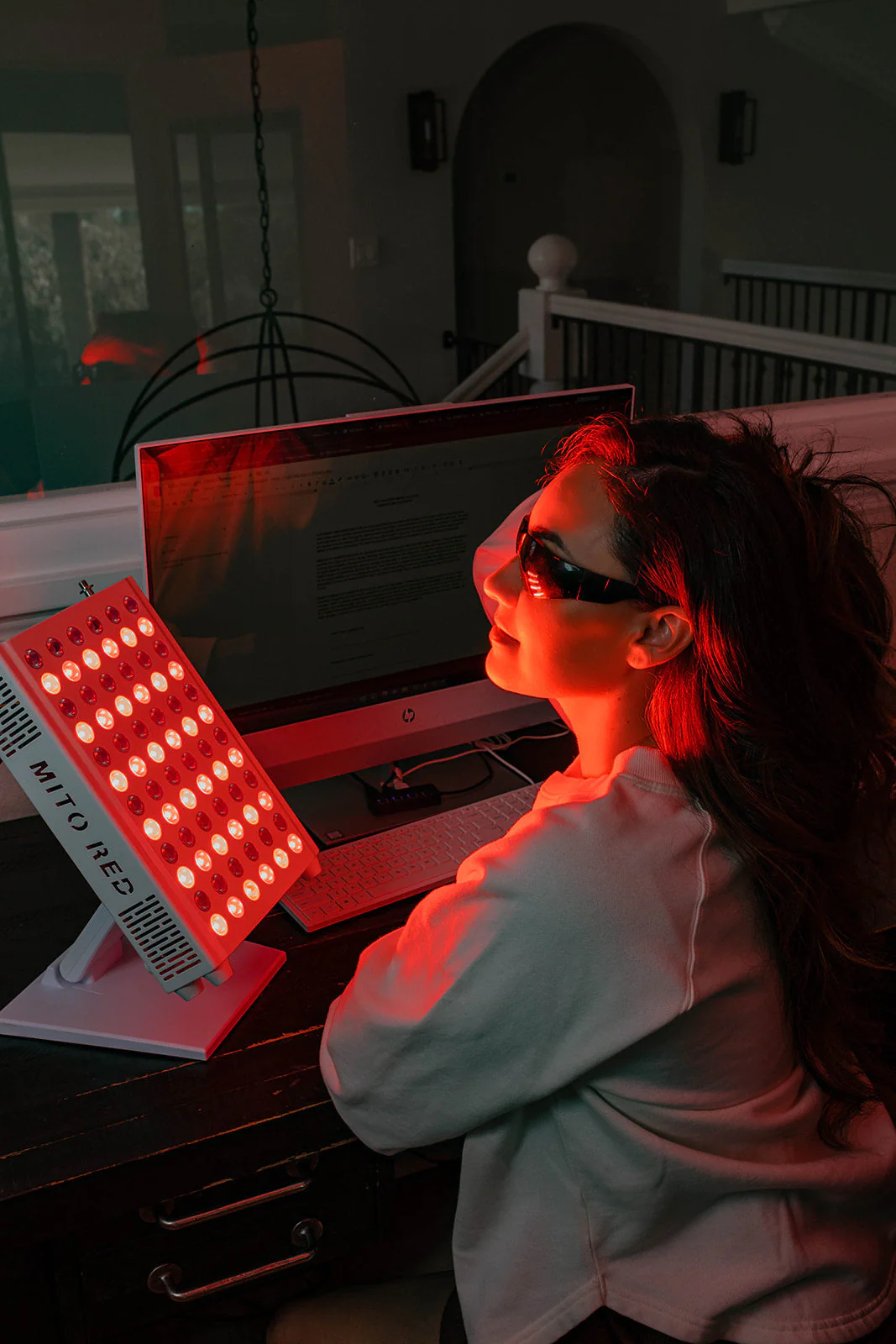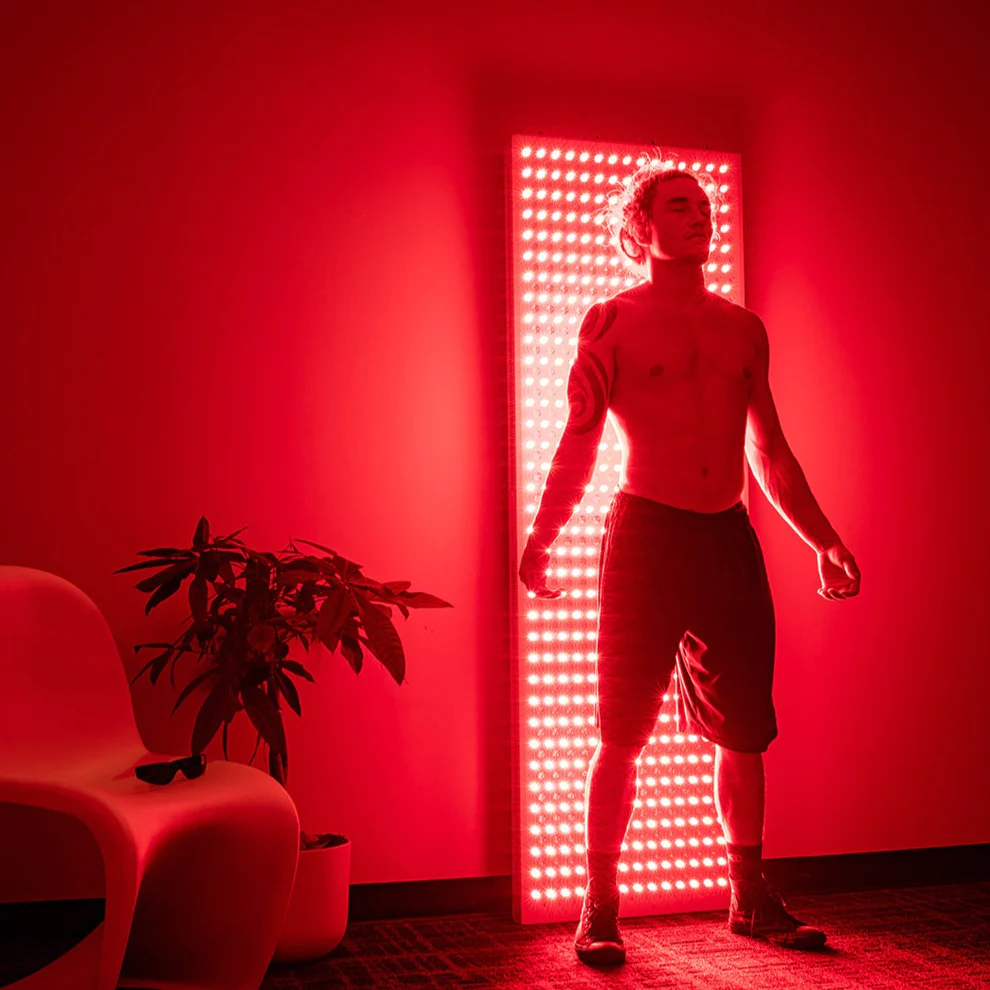A Detailed Guide to Red Light Therapy and Photobiomodulation
- Dylan Golden, MA
- Nov 3, 2023
- 12 min read
Updated: 5 days ago
Red Light Therapy is a cutting-edge treatment that uses the power of light to promote various health benefits. It may seem unconventional initially, but this non-invasive therapy has recently piqued the interest of many health professionals and health-conscious individuals for its potential to enhance healing and well-being.
In this blog, we will explore what red light therapy is, how it works, and the multitude of advantages it offers to those who decide to use it. From its roots in low-level laser therapy to its diverse LED light applications in the modern world, we'll discuss the science and practicality of this intriguing therapeutic approach.
Table of Contents: Please click on any chapter to jump ahead.
Light and its Role in Health
The power of light today is nothing new to society. Light is made up of energy, whether it's in a lamp or the sun. Many of us understand that exposure to sunlight can be a great source of Vitamin D, and sunlight has other great effects on the brain and body, too. For instance, safe exposure of the eyes to morning sunlight has been shown to have numerous positive impacts on health, including enhanced mood, improved sleep, circadian rhythms, and more (Using Light For Health, 2023). Safe exposure to morning sunlight also helps shut down the body’s natural nightly melatonin production, making it easier to start the day (2023).
So, if sunlight can influence such positive changes in the brain and body, how about other light sources like red light?
What is Photobiomodulation?
Red light therapy is a therapy of many names. Initially, it was called low-level laser therapy, then photobiomodulation (PBM). However, red light therapy (RLT) is just one category of light sources that fits under the umbrella of PBM.
Establishing what PBM is will help define what red light therapy is. PBM includes any color or energy light source that can modulate or modify the biology of a living person or thing. Picture the colors of the rainbow. Each color has energy in the form of light wavelengths (energy power) it gives off, which humans see as the color. The light waves in each color or light source that humans naturally see can be harnessed at different strengths into a PBM device to apply to and benefit the brain and body.

For example, blue light is a common light source of photobiomodulation treatment used in acne and skin care centers nationwide. When applied to the face or other areas, blue light kills acne-causing bacteria that build on the skin. The photo on the right is a device called the LightStim, which combines both red and blue light to get rid of mild acne.
Many other colors of light have differing positive effects on our biology. These include colors like violet, orange, purple, green, pink, and red. Green light has become increasingly prevalent for its many anti-aging

effects. Green light therapy can boost collagen and elastin, smooth out fine lines and wrinkles, and even help eliminate cellulite. At Better Brain & Body, we utilize a green light therapy device called the UltraSmooth, which helps people achieve natural anti-aging skin benefits with a non-invasive approach.
However, there are some forms of light wavelengths that humans cannot see. These light sources are outside of the visible spectrum humans can see, but still have the ability to change our biology. According to NASA, visible light wavelengths range from 380 to 700 nanometers (nm) (2010). Red light ranges from 630-700nm, which explains why we can see it. A common light source humans cannot see, called infrared light, is found in many RLT devices for its positive benefits and is in the range of 780-1000nm. Different RLT devices will have varying wavelength strengths that may be optimized for specific results.
Infrared Light: "The Invisible Light"
Infrared light is a light source humans cannot see. There are three different types of infrared light, each with varying positive effects when used on the body: Near, mid, and far infrared.
Near-infrared light is the type of infrared light used in red light therapy devices. Despite humans’ inability to see infrared light, it still has its place in healing.

For instance, infrared saunas have become prevalent in wellness today for their benefits, like detoxification, decreased inflammation, and pain relief, among others. Infrared saunas use infrared light (specifically far-infrared)–while this light may seem red, humans cannot see this light source, but we can feel its heat within. Most, if not all, RLT devices today also include the light wavelengths of near-infrared light but do not generate heat.
So, this begs the final question: what even is red light therapy?
What is Red Light Therapy (RLT)?
Red Light Therapy is a form of photobiomodulation that is pain-free, non-invasive, and shines low-level red and near-infrared light on the skin, yielding many health benefits with light. The LED lights may shine on the whole body or areas of the body over a consistent treatment period.
By exposing the body to specific light wavelengths, one may expect benefits that encourage enhanced healing and recovery time of tendons, muscles, tissues, bones, wounds, and cartilage, reducing pain and inflammation. The therapy also has added effects of improving energy, detoxification, increasing circulation, and enhancing nerve function, among other benefits.
RLT treatments are now widespread and take on different forms of devices. Handhelds, panels, full-body lights, face masks, beds, wands; the list goes on. They produce red light via LED lights or light-emitting diodes. Now, these devices are used in homes, medical clinics, gyms, spas, and professional sports teams nationwide.
Below, check out a range of different RLT devices featuring MitoRedLight technology. Use the code betterbrainandbody for a 5% discount on any of their products.
This blog post may contain affiliate links. This means that if you click on a link and make a purchase, we may receive a commission from the retailer. While this can help support our work and allow us to keep creating content, our primary goal is to recommend products and services that we genuinely believe in and that align with our values.
How Does Red Light Therapy Work?
Maintaining the health of our cells is important. Cells in the body have crucial daily tasks that keep us functioning throughout our lives. Inside our cells are mitochondria, the energy houses of the body. They are responsible for energy production, among other things. By shining red light therapy onto the skin, energy from the light is absorbed by mitochondria, strengthening the cells and making cells and the overall body-mind functions perform more efficiently and effectively. Maintaining excellent cellular health can bring other positive benefits that will impact short and long-term health and may even prevent the onset of neurodegenerative diseases later in life.
Red Light Therapy Side Effects
The research for RLT is ongoing, and many promising experts, including NASA scientists, are working in this field to better understand the positive impacts RLT can have and the potential side effects it may bring–since none have been discovered yet while using approved red light therapy devices properly and in the short term. Expanding on this, if one uses the device properly, according to their physician's or the device's instructions, they can expect a safe treatment with minimal side effects. However, those with certain conditions we will highlight next should speak to their doctor before using red light therapy.
Who Should Consider NOT Using RLT
People who are taking photosensitive medications or have Glaucoma or Lupus should consult with their physician before trying RLT. For other individuals, using eye protection is recommended but not required. Interestingly, RLT is currently being studied for its potential to offset age-related vision loss. While more research is needed, please follow the directions of your physician, wellness provider, or device manufacturer, and use eye protection unless directed otherwise. Overall, the science of red light therapy has shown no major adverse side-effects since scientists began studying it in 1967.
Red Light Therapy Controversy
RLT has been studied in the treatment of many different conditions, yielding many results. Despite discovering the power of red light therapy in the 60s, RLT remained a controversial medical therapy until the early 2000s. It wasn’t until 2001 that scientists with NASA proved red light therapy positively affected wound healing in humans. Similarly, they observed a 40% improvement in musculoskeletal injuries in Navy Seals (Whelan, 2001). Since then, many scientific benefits have been observed, as well as anecdotal evidence that has not been “proven” yet in the lab. Many different RLT devices have been invented, some with FDA approval and some without. Different devices will yield different results.
Red Light Therapy Benefits
Reduced Pain & Inflammation
Consistent observation of RLT shows reduced muscle pain and inflammation. Reducing

inflammation can be the key to alleviating symptoms of various ailments. RLT was even teased as an athletic performance enhancer as it may have the ability to heal or regenerate muscle tissue and increase muscle mass (Ferraresi, 2016). At Better Brain & Body, we utilize an FDA-approved red light therapy device called MLS Laser Therapy for relieving pain and decreasing average healing time, among many other benefits.
Conditions RLT May Help: Fibromyalgia, Arthritis, Joint Pain, Muscle Pain, Tendonitis, Osteoarthritis, Carpal Tunnel Syndrome, Athletic Training Performance
Anti-Aging Skin Benefits
Wrinkles, fine lines, sagging skin, and redness can also be alleviated with RLT. According to the Cleveland Clinic, RLT produces collagen via the fibroblasts, helping skin tone and texture while alleviating signs of aging over a continued treatment period.
Conditions RLT May Help: UV Sun Damage, Wrinkles, Sores, Redness, Scars, Fine Lines, Sagging Skin, Psoriasis, Aging Skin, Cold Sores, Eczema
Improves Acne
RLT is promising as a supplemental treatment for mild to moderate acne. It is thought that red light can kill acne-causing bacteria on the skin, but more research is needed.
Fat Loss
Specific red light therapy devices like the FDA-approved non-invasive UltraSlim have been shown to reduce fat and or circumference of specific body

areas. The UltraSlim doubles as a standard RLT device and a specialized RLT fat loss device. It is one of the only body contouring devices on the market that is non-invasive, pain-free, requires no downtime, and has no side effects. Studies show that UltraSlim allows people to lose at least 2 inches of fat on average every treatment session. Users of UltraSlim will experience many of the standard benefits that regular RLT devices give.
Conditions RLT May Help: Obesity, Individuals with Injuries Unable To Exercise, Post Pregnancy, Long-Term Health
Wound Healing
Enhanced wound healing is shown in both animals and humans who undergo red light therapy. Treatment time and wavelength dose are essential in observing the benefits of wound healing. On average, experts recommend one to two 20-30-minute sessions per day for all RLT treatments, as our cells can only absorb so much light energy. When used in conjunction with Hyperbaric Oxygen Therapy, the results of wound healing can be exacerbated (2001). RLT not only helps heal wounds but lessens pain and inflammation around the wound.
Conditions RLT May Help: Burns, Wounds, Scars, Surgery Incisions
Improvement in mild, Chronic TBIs
In a study with mild TBI patients, Naeser et al. treated patients with red and near-infrared light three times a week for six weeks. They found an increase in executive functioning, enhanced sleep, and less PTSD symptoms (2014). Family members of the patients treated reported “better social function and a better ability to perform interpersonal and occupational activities” (Naeser, 2014, p. 1011). This study and others are promising findings for the treatment of TBI and concussions.
Conditions RLT May Help: Mild TBI, Concussions, PTSD
Improved Autism Spectrum Disorder Symptoms (ASD)

A RLT headset device called the Vielight Neuro was used in a recent study on children ages 5-15 twice daily for 40 minutes, five days a week for six months. Vielight Neuro shines infrared light onto the skull and through the nose with a nose clip. The study results found reduced “cognitive and behavioral rigidity, an increase in sleep quality, improved attention spans, decreased autism severity, and reduced non-compliant behavior” (Pallanti, 2022, p. 9). Pallanti et al. also noted that these results were consistent with studies involving adults with ASD, showing that both adults and children with ASD may improve with RLT treatments. Lastly,

the authors stated that children’s ASD improvements also led to a “reduction in parental stress” (2022). Vielight Neuro is a therapy we consistently use at Better Brain & Body and plays a significant role in the healing process for patients.
May Help Neurodegenerative Disorders
The use of RLT has also been studied in neurodegenerative disorders. More research is needed on the effects it may have on Parkinson’s and Alzheimer's Disease (AD). At their own digression, some people have employed the use of RLT on their loved ones with AD and have reported improvements in their condition. Furthermore, with only a 2% medication development success rate for the treatment of Alzheimer's, scientific study results for RLT are eagerly expected (Kim, 2022, p. 87). However, significant improvements have been shown for patients with Dementia or mild cognitive decline when using the Vielight Neuro device, which also implements near-infrared light therapy. Saltmarche et al. observed improved cognition and other benefits after 12 weeks (2017). Participants noticed an increase in functional mobility and a decrease in incontinence. Lastly, the authors reported that sleep improved, outbursts of anger lessened, anxiety decreased, and so did aimless wandering (Saltmarche, 2017, p. 439).
Conditions RLT May Help: Mild Cognitive Decline, Dementia
May Help Acute or Moderate Ischemic Stroke
While more studies are needed to confirm the usefulness of RLT for acute or moderate ischemic stroke, one study showed how applying RLT to the head within 24 hours after a stroke showed significant improvement in stroke patients, with 70% of participants reporting a successful treatment even after 90 days (Lampl, 2007). The study used infrared light, commonly found in red light therapy devices.
May Help Psychiatric Disorders
RLT is currently being studied for therapeutic use for conditions like anxiety, depression, ADHD, and Seasonal Affective Disorder (SAD). While more research is needed for the first three, RLT has been shown to improve mood and symptoms associated with SAD. Using RLT shows improvements in sleep at night and daytime energy levels, maximizing the balance of our circadian rhythms.
Conditions RLT May Help: Anxiety, Depression, ADHD, Seasonal Affective Disorder (SAD)
Closing Out
Lastly, Red Light Therapy is a therapy anyone can use. The list above shows conditions and symptoms RLT may help, but it is a therapy that anyone can use to improve their health. It does not require a prescription. Some devices are FDA-approved, and others are not. Devices tend to be expensive, but you can find medical clinics like Better Brain & Body or wellness studios that offer red light therapy treatments at a reasonable price. Unless specified, a standard red light in your lamp or any other device is not the same as true red light therapy.
If you are interested in how red light therapy treatments may optimize your health, please schedule an appointment online using the button below or call us at 704-752-8100 for a complimentary 15-minute phone consultation with our lead physician, Dr. Alicia Brown, to discuss how you or a loved one may benefit from this treatment.
Looking for more daily hacks using light? Check out this podcast episode.
Affiliate Disclosure:
As you navigate through the content we create, it's important to be transparent about our relationships with the brands we mention. Here at Better Brain & Body, we strive to provide honest and valuable information to our readers. This blog post may contain affiliate links. This means that if you click on a link and make a purchase, we may receive a commission from the retailer. While this can help support our work and allow us to keep creating content, our primary goal is to recommend products and services that we genuinely believe in or that we use in our clinic and that align with our values.
To purchase your own red light therapy device, visit the following website and use our code betterbrainandbody for a 5% discount on any of their products.
Reviewed by Dr. Alicia Brown, DC, DACNB.
Sources:




